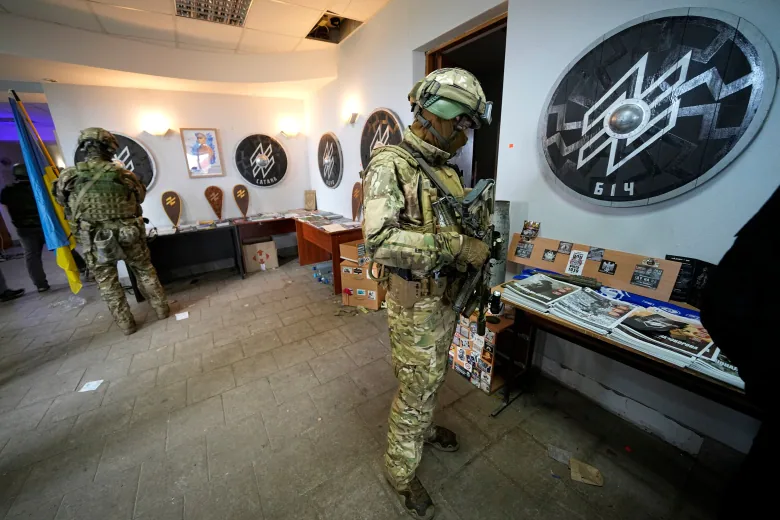
[ad_1]
Russia and its rebel allies are holding an estimated 1,000 Azov fighters prisoner, many since their surrender at the steelworks in mid-May. Russian authorities have opened criminal cases against them, accusing them of killing civilians. The addition of terrorism charges could mean fewer rights and longer prison sentences.
A terrorist organization’s leaders could receive 15 to 20 years, and group members could get five to 10, according to Russian state media.
In its ruling, the Supreme Court banned the Azov Regiment in Russia. That could also outlaw the regiment in areas of Ukraine occupied by Russian or Russia-backed forces, if those territories go ahead with plans to become part of Russia.

In testimony journalists were allowed to view, witnesses appearing before the Supreme Court supported the proposed terrorism designation, but most of the proceedings were held behind closed doors, so it was not known if any opponents testified.
“I can testify myself that Ukrainian snipers — Azov snipers — really shot civilians trying to escape the city” of Mariupol, Marina Akhmedova of the Presidential Council for the Development of Civil Society and Human Rights testified.
“I saw bodies lying on roads with my own eyes. There were many of them, and they were lying probably 10 metres apart from one another. There were no shell craters beside them.”
Regiment dismisses ruling
In a statement, the Azov Regiment dismissed the ruling, accusing the Kremlin of “looking for new excuses and explanations for its war crimes.” It urged the U.S. and other countries to declare Russia a terrorist state.
The Azov soldiers played a key part in the defence of Mariupol, holding out for weeks at the southern port city’s steel mill despite punishing attacks from Russian forces. Ukrainian President Volodymyr Zelenskyy hailed them and the other defenders as heroes.
Moscow has repeatedly portrayed the Azov Regiment as a Nazi group and accused it of atrocities, but has produced little evidence in public.
The regiment, a unit within Ukraine’s National Guard, has a checkered past. It grew out of a group called the Azov Battalion, formed in 2014 as one of many volunteer brigades assembled to fight Russia-backed separatists in Eastern Ukraine. The battalion drew its initial fighters from far-right circles.

While its current members have rejected accusations of extremism, the Kremlin has seized on the regiment’s right-wing origins to cast Russia’s invasion as a battle against Nazi influence in Ukraine. Russian state media has repeatedly shown what it claimed to be Nazi insignias, literature and tattoos associated with the regiment.
Last week, dozens of Ukrainian PoWs, including Azov fighters from the steel plant, were killed in an explosion at a prison barracks in Olenivka, an eastern town controlled by pro-Russian separatists. Moscow and Kyiv have blamed each other for the blast, with Kyiv saying Russia blew up the barracks to cover up torture against the POWs.
Ship with Ukrainian grain approaches Turkey
Meanwhile, the first cargo ship loaded with grain to leave Ukraine since Russia invaded more than five months ago approached Istanbul on Tuesday en route to Lebanon, testing an agreement Moscow and Kyiv signed last month to unblock Ukraine’s agricultural exports and ease a global food crisis.
An estimated 18 million tonnes of grain have been stuck in Ukraine since the start of war. The UN-brokered agreement to release the grain calls for the establishment of safe corridors through the mined waters outside Ukraine’s ports.
The Razoni, which set sail from the Black Sea port of Odesa on Monday with more than 23,000 tonnes of corn, was scheduled for inspection Wednesday in Istanbul by a team of Russian, Ukrainian, Turkish and UN officials, as part of the deal.
Russian and Ukrainian officials signed a landmark agreement allowing grain exports from Ukrainian Black Sea ports. The UN and Turkey brokered the deal.
More ships from Ukraine are expected to follow. At Odesa alone, at least 16 more vessels, all blocked since Russia’s invasion on Feb. 24, waited their turn, Ukrainian authorities said.
Global food prices have been soaring in a crisis blamed on the war, global supply chain problems and COVID-19. While Ukraine is a major supplier of grain to the rest of the world, the agreement may not make much of a dent in world hunger.
Most of the grain stuck in Ukraine is to feed livestock, according to David Laborde, an expert at the International Food Policy Research Institute in Washington. Only 5.4 million tonnes is wheat, and just half of that is for human consumption, Laborde said. He said Monday’s shipload is chicken feed.
“A few ships leaving Ukraine is not going to be a game changer,” he said.
[ad_2]


التعليقات